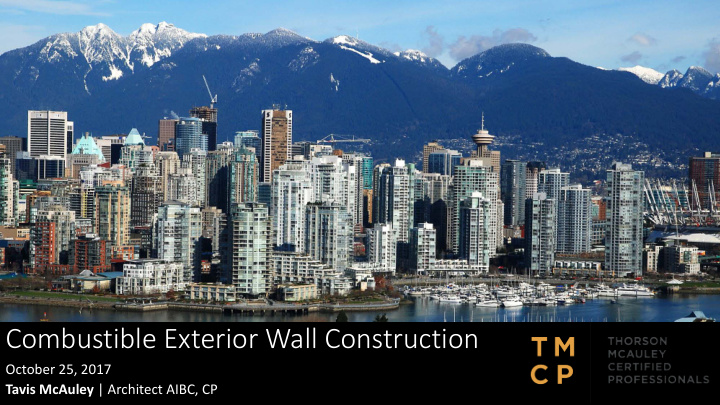



Combustible Exterior Wall Construction October 25, 2017 Tavis McAuley | Architect AIBC, CP
Agenda Combustible Exterior Wall Assembly in Buildings Required to be of Non-Combustible Construction • Building Code Requirements • Grenfell Tower Fire in Context • Overview of CAN/ULC-S134-92 – Fire Test of Exterior Wall Assemblies (S134) • Market Trends in Exterior Wall Design • Drawing and Site Review under the CP program
Building Code Requirements Exterior Wall Design - Relevant Sections of the Building Code: • Part 3 – Fire Protection, Occupant Safety and Accessibility • Part 4 – Structural Design • Part 5 – Environmental Separation • Part 6 – Heating, Ventilation and Air-conditioning A lot of • Part 10 – Energy and Water Efficiency aspects to balance Also Influenced by: • Municipal Planning and zoning requirements • BC Hydro • NFPA 96
Grenfell Tower Fire in Context
Grenfell Tower Fire in Context Original building Polyisocyanurate Aluminum Composite Fire blocking at slab exterior (exposed (foamed plastic) Panels (ACM) with edge (Polyisocyanurate concrete) insulation Polyethylene core (PE) insulation block)
Grenfell Tower Fire in Context 100% Curtainwall with no “cladding system” Window wall with exposed concrete Brick Concrete wall
CAN/ULC-S134-92 – Fire Test of Exterior Wall Assemblies
CAN/ULC-S134-92 – Fire Test of Exterior Wall Assemblies Exterior Wall Height of flame on Heat flux at 3.5m R-value of tested Outboard insulation Assembly Tested wall above opening above opening (max. assembly included in assembly 35 kW/m 2) (max. 5m) 21.2 kW/m 2 Trespa Meteon Kraft 2.5m R-9.0 Yes – 75mm NComb FR 14.5 kW/m 2 ABET MEG Exterior 2.75m R-7.9 No Grade Phenolic Panels Class A or F1 27.0 kW/m 2 Alucobond Plus (3A 3.0m R-7.9 No Composites USA Inc.) 6.9 kW/m 2 Swiss Pearl “Carat” 2.0m R-0 No (60mm air cavity)
Market Trends in Exterior Wall Construction Typical Assembly ASHRAE 90.1 - 1997 ASHRAE 90.1 – 2010 New CofV RZ Target Tested to S134 (R-15 +) < Passive House (R-30+) R-7.9 R-9.0 R-16.3 R-31.1 Cavity insulation 3” Outboard 4” Cavity and 4” 4” Cavity between framing at insulation with outboard insulation 8” Outboard 16” OC continuous z-girts with steel clips at insulation with at 16” OC 24”x24” OC thermal clips at 24”x24” * Illustrations on this slide were prepared by RDH Building Science Inc.
Market Trends in Exterior Wall Construction You are reviewing a set of drawings for a non-combustible highrise project and notice the typical wall assembly is comprised of: ½” interior GWB 3 5/8” steel studs 5/8” Exterior GWB 2” XPS insulation Thermal clips at 24” x 24” O.C. Swiss Pearl “Carat” cladding and associated support (per S134 test on previous slide) 1. The Certified Professional should: a) Reject the design and require compliance with the S134 tested assembly b) Reject the design and require masonry cladding in compliance with 3.2.3.8.(1).(a) c) Recommend use of non-combustible metal cladding which would permit the use of combustible insulation on elevations with 100% UPO permitted d) The addition of combustible insulation and thermal clips to a listed assembly is not a significant deviation and the S134 tested assembly should be accepted e) None of the above
Market Trends in Exterior Wall Construction a) Reject the design and require compliance with the S134 tested assembly b) Reject the design and require masonry cladding in compliance with 3.2.3.8.(1).(a) c) Recommend use of non-combustible metal cladding which would permit the use of combustible insulation on elevations with 100% UPO permitted d) The addition of combustible insulation and thermal clips to a listed assembly is not a significant deviation and this assembly should be accepted e) None of the above No S134 assemblies meets Part 3 and 10. Interpretation is required between the tested assembly and the proposed assembly. Reasonable modifications include: • Addition of Non-combustible insulation (mineral wool) • Addition of Non-combustible thermal clips • Compliance with compartmentalization of cavity (at every floor and horizontally). Note that mineral wool insulation is a fire blocking material so flashing does not need to penetrate insulation
Market Trends in Exterior Wall Construction Lets go to Scandinavia where they have been building highly insulated buildings for decades…
Market Trends in Exterior Wall Construction
Market Trends in Exterior Wall Construction Projected window Precast concrete openings to allow exterior wall for thick insulation assembly 12” mineral wool Thermal break at insulation (+/- R-40) eyebrow Curtainwall support projects glazing in plane with insulation
Drawing and Site Review under the CP Program Design Phase • Additional focus will be required for exterior wall assemblies with respect to Fire and Life Safety requirements of the Building Code. • Review exterior wall assembly schedule in detail for compliance with Part 3. All S134 assemblies should be clearly identified. Acceptable deviations noted. • Where combustible materials are proposed within wall assembly confirm details for compartmentalization and protection. • S134 test is a vertical test, not necessarily applicable for horizontal exterior soffit assembly. • Liaise with the AHJ early in design phase if deviations from the requirements of the building code are proposed. On-line tool: https://canadabuildingcode.dow.com/
Drawing and Site Review under the CP Program Construction Phase • Communicate with the contractor that there will be additional focus on exterior wall assemblies with respect to Fire and Life Safety requirements of the Building Code. • Review shop drawings for exterior wall cladding. Acceptable deviations noted. • Review shop drawings where combustible materials are proposed within exterior wall assembly and confirm details for compartmentalization and protection. • S134 test is a vertical test, not necessarily applicable for horizontal exterior soffit assembly. • Check materials shipped to site are consistent with approved shop drawings. • For projects with ACM panels confirm FR core (white) colour for buildings if non-combustible cladding (S134) is required. Black core = Polyethylene (PE) = Combustible White core = Fire Resistant (FR) = S134 compatible
Questions? Tavis McAuley | Architect AIBC, CP
Recommend
More recommend